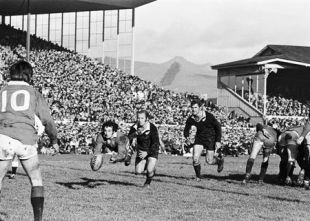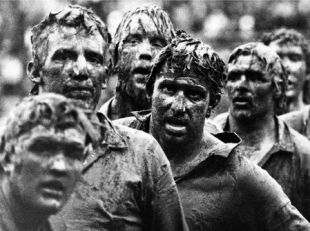|
Rugby World Cup
Capturing the All Blacks
Graham Jenkins
September 22, 2011

The Lions' Gareth Edwards feeds team-mate Barry John during their clash against the All Blacks in Christchurch in 1971
© Peter Bush/Otago Museum
Enlarge
New Zealand kicked off their Rugby World Cup campaign in front of a full house at Eden Park and a bumper worldwide TV audience but fans of the All Blacks have not always been blessed with blanket multimedia coverage of their side. For much of their glittering 117-year history the responsibility for conveying the fortunes of the team lay with a handful of trailblazers that included legendary photographer Peter Bush. Widely considered his country's greatest sports photographer, 'Bushy' has been a constant presence around the All Blacks since he recorded his first game on behalf of the New Zealand Herald back in 1949. In the ensuing 60-odd years he has captured all the definitive moments in New Zealand rugby history and the figures that have helped shape the game and it is a passion that sees him still covering the sport long past retirement age. That unprecedented contribution to the game is currently being celebrated by an exhibition of some of his finest work called Hard on the Heels that is touring the country to coincide with the World Cup. "Peter Bush is as much a part of rugby in New Zealand as any of the players that he has photographed," insists curator Rod MacLeod. "His ability to seemingly place himself into the heart of the game has resulted in a wonderful photographic record of the great non-professional era of All Black rugby, fixing in time great iconic moments of the giants of the age: the likes of Meads, Whineray, Clarke, Mourie, Tremain, Going, Kirkpatrick. Bushy became as recognisable to rugby fans as the players themselves, racing up and down the sideline in rugby boots to keep up with the action and to get the great shots." The modern age has seen many changes to the way the game is played while the reporting of the sport has also seen many development powered by inspiring technology but far from eclipsing the work of Bush and his peers, MacLeod believes it makes their contribution all the more precious. "The dawn of the professional era has brought great changes to the game, but this has only made Peter's pictures all the more valuable, not just for the record of players and games, but also as a social history of the more carefree New Zealand," he adds. "They recall crowds of men in hats, jubilant crowds right on the sideline and the hard cold light on winter afternoons. "Although the rules and conditions may have changed, the toughness and skill of the game remain as dramatic. Peter's description of rugby being a hard game played by hard men remains unchanged." The exhibition features over 100 images of great All Black moments varying from the controversial and contentious - Keith Murdoch's high-profile exit from the 1972 tour of Britain - to the celebratory - New Zealand's World Cup triumph - and is also laden with action shots and candid moments from behind-the-scenes. Bringing further colour to the history lesson on display at the Otago Museum are some memorabilia gems from local collector John Broughton, while Bush himself offers his own aural and written commentary.

The New Zealand Juniors look a little worse for wear during a clash with the British & Irish Lions in Wellington in 1977
© Peter Bush/Otago Museum
Enlarge
"The idea of covering rugby with a camera instead of playing held little attraction," he reveals before detailing the trauma of his first major assignment. "One of my first big games was in 1949 when the All Blacks who could not tour South Africa because of that county's racial policies played Australia on Eden Park's No.2 ground. Like the All Blacks facing the Aussies that day, who were regarded as a second string team because the main All Black players were in South Africa, I was very much at the game for experience. The Australians ran out deserved winner 16-9. New Zealand's points came from a try to Roper, a penalty kick and a brilliant drop kick from Johnny Smith. "On leaving the ground swinging the heavy Graflex, I dropped the camera, and most of the glass plates I had exposed of the game were broken. Luckily for me, the senior photographer I was working with that day had safely secured adequate coverage of the game." The photos themselves offer so much in terms historical record but the thoughts of Bush himself take the images and memories to an all new level. An emotional Bush breaks down whilst describing the day he captured Murdoch heading home after being punished by All Blacks management for his role in a late-night fracas at the team hotel. His tears underline the close relationship he had, and still has, with the team whilst also perhaps reflecting the guilt of those who were close to the event but did not stand up for the under-fire Murdoch. Humour also figures strongly with one anecdote surrounding a picture from a 1964 clash with Australia raising a smile. As usual, Bush was in heart of the action and ventured into the All Blacks' huddle at half-time for a great shot of the side re-grouping. Spying a slice of orange intended for the players, Bush, who used to wear rugby boots to keep up with the action, saw the opportunity to refresh himself only to be chastised by Colin 'Piney' Meads who said: "I don't remember seeing you pushing in the scrum, Bushy!" The World Cup also features in the exhibition - although the iconic picture of All Blacks captain David Kirk with the Webb Ellis Cup was taken by Russell Cheyne - and many stars of the sport's showpiece event have been propelled to greatness through his lens like former winger Jonah Lomu. The giant wing carved name for himself at the 1995 tournament in South Africa but Bush was equally impressed with his performances off the field having witnessed his "grace" first hand thanks to his privileged access to all things All Black.

The All Blacks and Springboks vie for the ball during a clash in Christchurch in 1965
© Peter Bush/Otago Museum
Enlarge
"In the run up to the Rugby World Cup in 1995, Jonah had gone to visit an old ladies' home and with the grace of his country he shook hands with one lady and as she went to stand up he stopped here and leant over and kissed her. Then quietly and patiently he kissed each lady in turn, until he reached the oldest lady at which point he took an All Blacks cap out of his pocket put it on her head before kissing her on both cheeks. She then said, 'I'll be listening every minute that you play when you go to South Africa for the World Cup.' That was a special moment involving a special player who was also a very special young man. It showed his great grace and warmth. Forget about his prowess on the field, he was equal to it off the field. " A resident of Island Bay in the suburbs of Wellington, the 80-year-old Bush was honoured by the New Zealand Rugby Union for his services to rugby in 2005 and more recently was made Companion of the New Zealand Order of Merit in the 2011 New Year Honours. His autobiography, A Life in Focus, was published last year but far from drawing a line under his working career he will still be seen with camera in hand during this World Cup although he confesses to being a "Luddite" and "overwhelmed" by the digital era. "It still amazes me that you have a card with the capacity to take 350-500 quality images," he recently told D-Photo magazine before suggesting technology and the competition may be about to finally overtake him. "With these World Cup games, it'll be like sitting on a crowded commuter bus, shoulder to shoulder. You see the try is coming just in front of you, think 'here's an exclusive' and then hear the whirr of 50-60 cameras. OK, your shot looks great but then you look to either side and theirs look better." But while they may pip him to the best shot they have some way to go to match his impressive portfolio. © ESPN Sports Media Ltd. Graham Jenkins is the Senior Editor of ESPNscrum and you can also follow him on Twitter.
|
Live Sports
Communication error please reload the page.
-
Football
-
Cricket
-
Rugby
-
- Days
- Hrs
- Mins
- Secs
F1 - Abu Dhabi GP
Abu Dhabi Grand Prix December 11-131. Max Verstappen ()
2. Valtteri Bottas (Mercedes)
3. Lewis Hamilton (Mercedes)
4. Alexander Albon ()
5. Lando Norris ()
6. Carlos Sainz Jr ()
-
ESPNOtherLive >>
Golf - Houston Open
Snooker - China Open
Tennis - Miami Open

